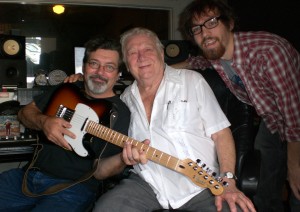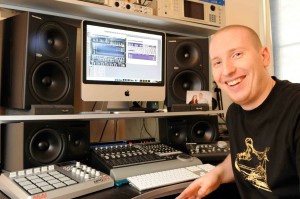Sometimes A Road Sings In the Mind of the Darkly Inclined
Composer, producer, remixer & musician Justin Lassen
By Randy Alberts

“For me it all started with Cakewalk, a keyboard, and a lot of free time,” laughs the globetrotting Justin Lassen, a one-of-a-kind visionary 27-year-old film, game and music soundtrack composer based in Southern California.
A designer, multi-instrumentalist and self-described “heavy Sonar guy,” to boot, Lassen is also one of the most creative composers, remixers and producers in the film, game and music industries today. He’s a talented film soundtrack remixer who recently reworked the score of Clive Barker’s Midnight Meat Train, a dark film take on the producer’s 1984 short story of a photographer tracking a serial killer, into a full length companion album to the movie. Lassen has also produced music remixes for Nine Inch Nails, Madonna, Garbage, Linkin Park, Lenny Kravitz and Blue Man Group and he’s consulted on numerous game and technology projects for companies like Interplay, Novus Delta, Intel and, of course, Cakewalk.
Interviewed by Playboy, Mix, EQ, GearWire, PC Gamer and other arts and trade mags and sites, Lassen’s a darling of the computer-generated graphics art world, as well. A rare musical subject for numerous CGI trade magazines such as Post, It’s Art, The Escapist and CG Society Magazine, he literally can translate the inspiring, hauntingly beautiful visual art he sees into his own musical performances, arrangements and remixes. It’s a phenomenon of the senses called ‘synaesthesia’ he’s personally well acquainted with: Seeing sound, hearing scents, touching words, smelling colors. If the set and setting are just right, what Justin views through his irises can literally become real-time music from his fingertips.
“I’m a visual artist, designer and programmer,” he adds, “who just finds music much more fulfilling.”
Smells Like A Symphony, Tastes Like Sonar 7
Lassen, who happened to be Cakewalk’s Featured Artist of The Week for August 25, 2008, released his own CD, And Now We See But Through A Glass Darkly, in 2003 to acclaim from leading international CG artists, film, game and music professionals. This disc of his own uniquely composed and produced dark chamber symphonic suites has already reached 5.5 million copies in circulation. His debut CG release in 2006 of Synaesthesia then melded Justin’s two worlds of “beautiful dark symphonic” music and CG artwork again to critical peer praise, and earlier this year while in Europe he wrapped up the final release: Synaesthesia Encore, a new collection of pieces that musically addresses Justin’s own personal experiences with the phenomenon.
“Synaesthesia is something that has taken quite a hold of me over pretty much my entire musical career and life,” explains Lassen. “I have had some of my best compositional and performance moments in these types of situations, where I can actually feel an image playing the song right before my ears, completely and naturally. When I see visual work like this that really inspires me in this way, my fingers begin to play music very magically.“
Remarkable. Much to his liking, Justin’s successful role in creating the remixed soundtrack CD for Barker’s wide-released Midnight Meat Train is now attracting interest from other film, music and game audio producers, as well. An always-on, busy musician, remixer and symphonic arranger who travels for his music extensively and just returned from an exhaustive trip across the EU and back to his home studio in California, nothing would please the affable Lassen more than to score more symphonies and movie soundtracks for a living.
“I use Sonar 7’s notation features to clean up my arrangement ideas for orchestra, choir or other performers I might bring into a given session,” says Lassen about his go-to laptop DAW.
“I recall this one time in Paris when I was asked by Intel to do the soundtrack for a new high-tech game for a new platform. There was a pretty tight schedule of just three weeks, and I didn’t have a lot of gear to experiment with. So, I just used FL Studio on a laptop to jot down some ideas that later I would evolve and finish up back in L.A. and Phoenix. I then took those sketches and beats and brought them into Sonar and added many of the orchestral and electronic elements, as well as tracking all the guitars and vocals and doing the final mixing and mastering. I then cleaned it all up and converted the files over to OGG format, for the Unreal Engine 3 the game uses, all quite easily and well before my deadline.”
Continue reading “Artist Spotlight: Justin Lassen”
 British Comedian Al Murray ends every show with a song and dance. On this year’s tour, he’s featuring a self-composed track, “Broken Britain Boogie” as the finale.
British Comedian Al Murray ends every show with a song and dance. On this year’s tour, he’s featuring a self-composed track, “Broken Britain Boogie” as the finale.







